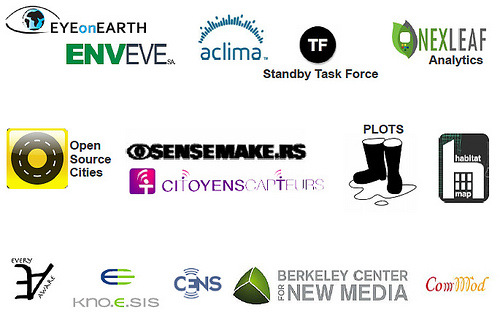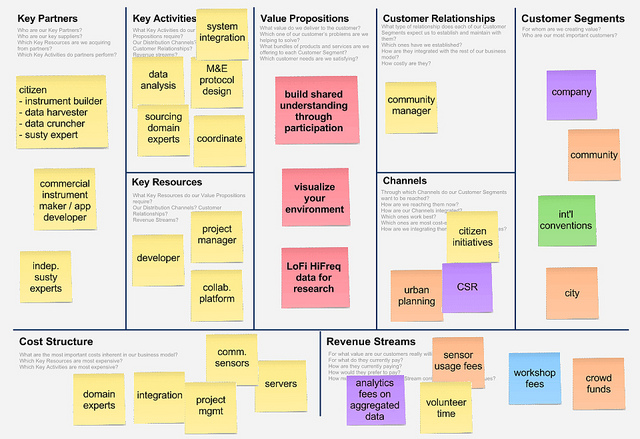
Photo by steven w
Long Pause
It’s been a while since my last post. I started working with Ness Technologies back in November, attended a couple of Coursera classes and Twitter decided to shut Posterous down forcing me to move my modest blog elsewhere. Now that the induction period is behind me and the posts are migrated, I am looking forward to further develop ideas around citizen participation, coordination in networked environments, Internet of Things, and other innovations that are re-shaping the way we live in cities and define our civic selves.
Just before joining Ness, I was able to attended a Citizen Sensing event in Paris at La Cantine organized by Labo Citoyen back in November 2012. The main focus of the evening was on understanding air quality issues and to introduce their DIY sensor Gasser. I was kindly given the opportunity to present an overview of citizen sensing initiatives which reside in my eyes at the intersection between citizen science, sustainability in an urban world and civic activism. The 3 key points I tried to bring across in the context of data gathering by engaged citizens were :
- Soft sensing (direct human observation submitted via web/mobile) and hard sensing (using sensors) are still rarely used in combination on projects (see doc)
- Need to learn from (1) citizen science and (2) crisis mapping and study successful observation protocols and mechanisms to drive participation (I recommend following Caren Cooper and Patrick Meier for these domains respectively)
- Gain greater systemic (read: holistic) understanding of system-in-scope through modeling and a shared model of understanding which will bring meaning to the data collected - sensemaking of sorts
In December, I developed the same points at IoTZH adding an overview of existing organizations partially embracing the points above.

At the top are those which appear to me as environmentally-driven with Standby Taskforce as the outlier with its focus in crisis mapping. The middle group (no hierarchy implied) represents organizations with a civic drive. Finally, the bottom group shows research organizations which incorporate citizen participation. I included the lesser known French ComMod (Companion Modeling) which leverages evolutionary agent-based models and role-playing games to understand complex land systems and facilitate its collective management.
Sensemaking as a Business
The organizations shown above have the ability to mobilize citizens and communities around issues related to sustainability relevant to their particular region and/or raise awareness. In some cases also drive change. They do this in a sustainable way, i.e. adhering to some kind of business model which allows them to become the best at what they do, project after project. Would there be a way to capture the basic blocks of a business model for citizen sensing? To attempt answering this question I’ll build upon the business model canvas, a tool devised by Alex Osterwalder and Yves Pigneur.
Business Model Blocks
Alex built his career on the study of business models. His PhD work on the subject allowed him to gain a good overview of the methodologies available and lead him to devise a basic model made of 9 blocks which describe how an organization delivers value. I like to think of this canvas as a Tangram where all pieces have to be used but you can determine their layout. Unlike regular puzzles, there are many good answers. Over time, he demonstrated the use of his canvas with multiple organizations such as VoIP service providers, fast-moving consumer good companies, or private banks among many others. If you are interested, I definitely recommend his book Business Model Generation. For those who are not familiar with the model, I’ll recap here the meaning of the 9 blocks.
- Value Proposition
- What value do you deliver to the customer? Which of their problem(s) are you solving? What bundle(s) of products or services are you offering to each segment? Which customer needs are you satisfying?
- Custom Segments
- For who are you creating value? Who are your most important customers?
- Channels
- Through which channels are you reaching your customer segments? How are your channels integrated? Which ones work best? Which are most cost-efficient? How are you integrating them with customer routines?
- Customer Relationships
- What kind of relationship(s) do your customers expect to establish with you? How are they integrated with the rest of the business model? How costly is it to maintain these relationships?
- Key Partners
- Who are your key partners? Who are your key suppliers? Which key resources are being acquired from partners? Which key activities do partners perform?
- Key Activities
- What key activities does your value proposition require? What about distribution channels, customer relationships and revenue streams?
- Key Resources
- Similarly to key activities, ask questions related to resources.
- Cost Structure
- What are the most important costs in your business model? Which key resources and key activities are most expensive?
- Revenue Streams
- For what value are your customers willing to pay? For what do they currently pay and how? How would they prefer to pay? How much does each stream contribute to the overall revenue?
As you can see, getting started with this canvas is relatively easy and Alex often performs live exercises with groups attending his workshops. A template is available to get you started and suggest a set of items specific to citizen sensing.
Citizen Sensing Canvas v0
Below a version zero of the canvas for self-sustained citizen sensing activities. I’ll start the description from the center piece of the canvas describing the value proposition.

The value proposition of a citizen sensing organization is threefold: build shared understanding and trust through participation, visualize environmental impacts and gather low-fidelity, high-frequency data usable for research. Low-fidelity refers to the fact that citizens may not gather high-precision data compared to professionals. Instead, citizens collect larger quantities of lower-precision data. Taking the example of air quality, traditional approaches consist of deploying a few sampling stations with advanced equipment and feed collected data to a predictive model which calculates the quality metrics across a wider space, including areas where there are no sampling stations. The Environmental Protection Agency in the US has been experimenting with this method. Producing shared models of understanding, considering their potential complexity, remains under-developed but is essential for systemic thinking. Visualization plays a key role here as demonstrated by Greg Niemeyer with his Blackcloud.org project.
Which are the customer segments interested in such citizen sensing services? I see private organizations, communities, international conventions, or cities. Peter Senge in his book The Necessary Revolution mentioned how Coca-Cola faced pressure from communities in India suffering from drought while the soda giant steadily extracted water for its beverages. Ramsar, the internation convention on wetlands, sends experts to assess protected areas and provide guidance to locals. Transition town communities go about identifying re-skilling individuals able to educate people in a wide range of crafts. Finally, cities seek savvy citizens to locate inefficient use of resources or simply infrastructure in need of maintenance. All these examples can benefit from the citizen sensing value proposition and bring some sense to raw data captured by individuals themselves.
Channels and customer relationship structures will vary according to the segments targeted. I set for now a community management structure for relation management and varying channels such as Corporate Social Responsibility (CSR), urban planning or citizen initiatives as channels to access the segments. I suspect these structures are still too vague and reflect my limited of knowledge of these channels. I ask myself for instance if organizations such as New Cities Foundation cannot play a key role here for instance?
On the execution side of the value proposition, citizens are identified as key partners alongside instrument makers and sustainability experts. As Annie Leonard puts it in The Story of Change we are great at flexing our consumer muscle. Contributions range from instrument making to data analysis through data collection across areas of interest. What’s key here is that citizens dedicating time for micro-actions engage into the systems thinking part as well - at least to understand what their data or instrument is actually being used for. It’s not plugging a device and becoming just another pin on a crowdsourced data map… Citizens embarking on a data gathering routine develop, with the assistance of domain (susty) experts, shared models of understanding explaining the relationships between the observations gathered and other variables related to their particular environment. Susty experts (I think of people like Krystyna Stave of UNLV or Alan AtKisson of The AtKisson Group for example) can help make sense of the data by working out an initial shared model of understanding to be refined over time.
Key activities in the execution of citizen sensing projects include system integration, data analysis, monitoring & evaluation protocol design, sourcing the necessary susty experts and coordinating the activities. This is reflected by the internal roles including a developer and project manager.
Last but not least, there’s the bottom row of the model which suggests a possible way to balance costs and sources of revenue for citizen sensing activities. On one hand, there are consulting fees to susty experts, specific integration costs for solutions which present a very high degree of variability at the edge of the architecture, project management costs, data hosting servers and actual sensors or data collection instruments including mobile apps. On the other hand, to balance these costs, I identified collecting sensor usage fees, crowd funds, fees for running citizen workshops, fees for data analysis of raw data collected and finally citizen volunteer time itself. The idea behind sensor usage fees is that using sensors is a transient activity. Hardware sensors should not end up on a shelve or in a drawer - such instruments can be passed around and serve multiple purposes when they are multi-modal like the Sensaris Senspod.
Iteration Zero
This canvas is just a starting point for discussion. As there you find multiple tangram shapes, my Post-It notes are just one variation on the canvas I came up with for citizen sensing organizations. Iterations would be required to further explore business model alternatives and unlock value. The organizations shown at beginning of the post are already fairly advanced in their own iterations and will eventually lead to legitimate bottom-up instruments which will hopefully balance with our other BAU solutions, namely markets and laws. We’re heading towards an urbanized future in which data and its use will matter as much as it to a formula one team and its heavily instrumented car. Dan Hill of Fabrica recently held a talk on how active citizens can make common sense cities. He concluded with the following points.
- Address public good beyond connectivity and infrastructure
- Use design to ask questions
- Understand drivers not just enablers
- Design conditions for systemic change, beyond popup solutions
Refining the model presented here would, I believe, be a great tool in a larger toolbox to contribute in a smart way to our cities’ shared purposes.
 This material is licensed under CC BY 4.0
This material is licensed under CC BY 4.0
